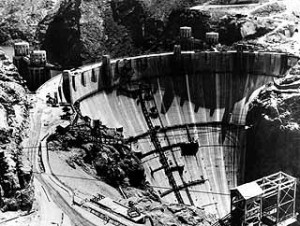The Hoover Dam, originally titled the Boulder Dam, is located on the Colorado River in Black Canyon sits between two states: Arizona and Nevada. At the time of its construction, which began in 1930 and was completed in 1935, the Hoover Dam was the largest electric-power generating site and largest concrete structure in the world. It has since been surpassed by other dams built by other countries such as China, but it is still one of the largest dams in America standing 726 feet high, 1,244 feet long, and weighing an impressive 6.6 million tons.
The Hoover Dam was funded by the federal government, but constructed by a collaboration of 6 companies consisting of Morrison-Knudsen, the Utah Construction Company, the Pacific Bridge Company, the Bechtel Corporation/Henry J. Kaiser, MacDonald and Kahn, and J.F. Shea. By the end of its construction, the Hoover Dam project had provided roughly 21,000 men with jobs and cost about $50 million in terms of 1931 dollars, but would have cost around $690 million in 2008. The fact that the dam project created so many jobs was extremely beneficial to society because many men had lost their jobs to the great depression. Also, the promise of jobs attracted people out to the western area where the Hoover Dam is located, promoting the economic and social growth of that region. Today the tourists who come to see the dam supplement this process; they continue to provide an additional benefit of incoming profit, which ultimately benefits the surrounding area. Throughout the dam’s construction, an estimated 96 men died on the job.
The Hoover Dam implements an arch-gravity structure, a choice made in order to harness the strength provided by both an arch dam and a gravity dam. The arch structure of the dam redirects the water pressure to the walls of the canyon and typically requires less material than other types of dams, whereas a gravity dam utilizes its sheer size to combat the constant pressure applied to its walls. The main benefit of a gravity dam is its simplicity of design and construction process. The combination of these two types of dams into the Hoover Dam’s structure has been extremely effective in displacing the water pressure of the Colorado River since it completion.
The Hoover Dam is very successful in accomplishing the jobs it was initially built for including flood prevention, irrigation, and the creation of hydroelectric power, but it has some drawbacks as well. It is an instrumental part in providing water to over 25 million people in the southwest United States, and the irrigation aspect has enabled farming to take place in a region that was far too dry previously to effectively grow and feed a significant population. Also, at the base of the Hoover Dam sit 17 generators, each of which could “produce up to 3 million horsepower and provide electricity for three states” (History.com). One drawback to the dam is the drop in temperature of the water, which has resulted in the extinction of multiple species of fish. Also, the creation of the Hoover and other dams prevents the water from flowing into Mexico, so the area where it used to flow is deprived of the lush environment that used to exist on the river’s banks.
Overall, the Hoover Dam was an extremely beneficial engineering project and is the main proponent behind the growth of the region in which it is located. It paved the way for the future of mega dams, and although it’s true that there are some negative environmental impacts, but I think that in this situation, the pros outweigh the cons.
Works Cited
Basar. Hoover Dam from Air. 2007. Wikimedia Commons. Wikimedia Commons. Web. 22 Apr. 2014.
Brean, Henry. Hoover Dam Construction. 2005. Las Vegas. Daily Journal of Commerce. Web. 22 Apr. 2014.
History.com Staff. “Hoover Dam.” History.com. A&E Television Networks, 2010. Web. 22 Apr. 2014.
“Hoover Dam Facts & Frequently Asked Questions and Answers – FAQ’s.” SunsetCities.com. SunsetCities.com, n.d. Web. 23 Apr. 2014.
Mickens, Samantha. “The Colorado River.” Cochise College – Student Papers in Geology. Cochise College, 2006. Web. 22 Apr. 2014.



v good topic and analysis. Clear tradeoffs – at least there are major benefits